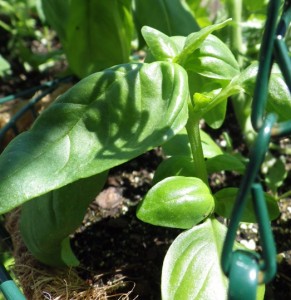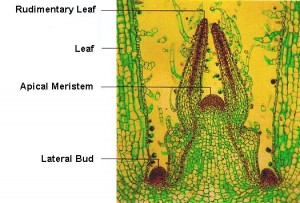 “Rosa whispered again, “Willy, you did squeeze me, so I will pinch you.” And she pinched. “Ow!Who pinched me?” said Cousin Joan. “Oh, Joan!” said Rosa. “I wanted to pinch Willy, not you.” “And she squeezes, too,” said Willy. Do you know what you two are?” said Cousin Joan. “You are little alligators. Now be still. I want to read.”
“Rosa whispered again, “Willy, you did squeeze me, so I will pinch you.” And she pinched. “Ow!Who pinched me?” said Cousin Joan. “Oh, Joan!” said Rosa. “I wanted to pinch Willy, not you.” “And she squeezes, too,” said Willy. Do you know what you two are?” said Cousin Joan. “You are little alligators. Now be still. I want to read.”
(“No Fighting, No Biting!” Else Holmelund Minarik, 1958)
We are now (well, where your Aunt Toby is, at Chez Siberia – anyone who gardens someplace in a higher climate zone has probably already faced this issue, but still) at a stage where annual plants (whether flowers or veggies) have settled in nicely, are rooted firmly, are sending out some good growth and in general, look like that basil plant at the top:
The growing tip at the top is sending out leaves and farther down the stem between the other big leaves are little leaves, nestled in their little spots. What to do?
Well, we could just let that be and the growing tip will just keep on growing up and up and those little leaves farther down won’t come to much. Or, we can pinch out the top and those little leaves farther down the stem will start to develop into branches. This is a clever, old fashioned trick used by gardeners probably ever since someone stuck a stick in the ground and dropped something into it to grow. If you want a fuller plant, whether it’s basil or petunias or impatiens or whatever, you literally ‘nip it in the bud’ and it will perform in that way.
Why? Yes, you in the back – the one with the silly grin. “You’ve removed apical dominance”
Ah yes, the answer to all things – ‘remove apical dominance’.
Before we can explore this we need to all be singing out of the same hymnal, as a former supervisor of mine used to put it. Let’s get some common vocabulary (and for those whose high school botany is still with them, you can go out to the kitchen and get a lemonade or something).
 Please turn your attention to this micrograph of the tip of a growing plant (very sciency looking, eh?). That bump in the top center is the ‘apical meristem’ (there are other apical tissues in plants, as at the tips of the roots – those are referred to as ‘apical’ as well, so apical refers to regions where active growth is taking place). The lateral buds that you see farther down develop into those rudimentary leaves that nestle between leaves and the stem, as on the basil at the top. Lateral buds have all the genetic messages encoded to allow them to grow, but the apical meristem produces a chemical, auxin, which inhibits the growth of the lateral buds. From an evolutionary aspect it’s sort of a “I’ve got mine and I’m going to make sure I get to the top and get all the sunshine first’ sort of messaging. When you remove the apical meristem, you are basically removing this ‘jamming device’. This wakes up the lateral buds and allows them to grow, thereby giving you a fully, more lush plant.
Please turn your attention to this micrograph of the tip of a growing plant (very sciency looking, eh?). That bump in the top center is the ‘apical meristem’ (there are other apical tissues in plants, as at the tips of the roots – those are referred to as ‘apical’ as well, so apical refers to regions where active growth is taking place). The lateral buds that you see farther down develop into those rudimentary leaves that nestle between leaves and the stem, as on the basil at the top. Lateral buds have all the genetic messages encoded to allow them to grow, but the apical meristem produces a chemical, auxin, which inhibits the growth of the lateral buds. From an evolutionary aspect it’s sort of a “I’ve got mine and I’m going to make sure I get to the top and get all the sunshine first’ sort of messaging. When you remove the apical meristem, you are basically removing this ‘jamming device’. This wakes up the lateral buds and allows them to grow, thereby giving you a fully, more lush plant.
Now, this will work while the plant is actively growing – but remember, with annuals, once they flower and start to set seeds, their messages change over from ‘grow, grow’ to ‘time to die off’. So, pinching will grow early in the growing season but not later in the growing season.
Now, pinching can be done with a number of plants in the garden, though the ones most gardeners are familiar with are tomatoes. If your tomato plants are still less than 6” tall, you can pinch out the growing tip. This will make the lower branches of the plant start growing and you’ll have a much fully plant. If the plants have already started setting flower buds, then you don’t want to do that. You can perform the traditional (and only on the indeterminant type of tomato – the ones that grow and grow and grow) ‘desuckering’ – removing those lateral buds, the little branches between the larger branches.
With indeterminant tomatoes, they will keep forming flowers and tomatoes until they get killed by a frost. Or, until they ‘think’ they are getting a frost or a frost-type event which would kill the growing tip (the apical meristem). If this happens and the meristem is damaged, the plant will go into ‘mature the fruit’ mode. So, let’s say you are getting to the end of August and you still have green tomatoes and you are concerned that the weather for the month of September is not going to cooperate with you. What do you do?
You give the tomato plants a ‘frost-type event’ – you cut off or break off the growing end (or ends in the cases of indeterminant tomatoes) – this will work with determinent tomatoes as well since they only grow so big and stop. The plants will then go into ‘mature the fruit’ mode and your tomatoes will start to turn red (or yellow or pink or orange or whatever color means ‘this is a ripe tomato’ for that particular variety.
So, if you are still in the recent stages of planting out (either in containers or in the ground), check out your flowers and veggies and pinch out the tips.
(note: I have no idea where that micrograph of the apical meristem is from – I found it on the internet in several different places, with no credit given whatsoever. Sorry)
So how is everyone else’s garden growing? I’ve got open flowers on the tomatoes in the hanging baskets; otherwise, things are still struggling along in the rather cool weather we’ve had this week.
